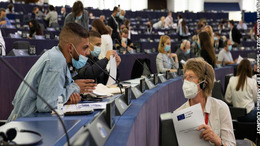Yet, when we start digging deeper to understand how Europeans are experiencing the social and economic progress that the headline figures suggest, the picture blurs. There are great differences in social conditions across EU countries and regions, and the global economic and financial crisis, which led to a double-dip recession in the EU between 2008 and 2013, has in many areas added to the disparities within and between European societies. These ruptures in the social fabric across Europe become particularly apparent if one looks beyond aggregate economic and labour market figures and takes into account other factors that determine the quality of living and working in Europe: the availability and quality of work, gender equality, access to services such as healthcare, or the chance to live and work anywhere in the EU.

Jacek Dylag / Unsplash - Unsplash License, https://unsplash.com/license
How are you doing, Europe? Mapping Social Imbalances in the EU
At the end of May, Europeans will elect a new European Parliament and soon after a new European Commission will begin its five-year mandate. The political changing of the guard in the European Union (EU) takes place after a period in which the European economy recovered from the economic crisis: per capita income has been growing by about two percent annually for the last three years, and growth has recently returned to every EU member state. Unemployment has been falling across the EU in the last year and now stands at an average of 6.7 percent – marking a new all-time low. But are these developments reflected in the daily lives of Europeans? This question seems even more pressing as recently, the economic recovery seems to slow down.
Getting to grips with social conditions across the EU
Concern about social imbalances is also reflected in Europeans’ views
When asked by a 2017 Eurobarometer survey about the most important challenges for the EU at large, social issues such as unemployment and inequality rank highest among Europeans – before migration, security, public debt and low growth. These concerns are not confined to poorer member states: According to the survey, 50 percent of Germans and 46 percent of Swedes considered social inequalities as among the most pressing challenges in Europe. Moreover, only one in two Europeans agrees with the statement that everyone in their country has a chance to succeed in life. And 84 percent of Europeans think that income differences in their country are too great. Hence, despite visible economic progress, a large majority of Europeans worries about social cohesion in their own country and in Europe.
Focus on six pressing social challenges
This observation is the starting point of our report. We set out to get a better understanding of social conditions across the EU. The report has three aims: First, we provide new – and perhaps surprising – perspectives on well-known social challenges in Europe. Second, we zoom in on concrete examples of living and working conditions to illustrate how they directly impact upon Europeans’ daily lives. Third, drawing on many case studies collected across different countries and regions, we provide a nuanced portrait of the – often very disparate – social conditions across the EU today. By doing so, we hope to contribute to the debate on how Europe is doing – and what is needed to make Europeans better off.
We selected six social challenges based on whether they are relevant for a large number of Europeans across different member states and regions and whether they have a direct impact that people may experience in their daily lives. We draw both on various sets of indicators and monitoring reports, as well as on a broad range of case studies that allow us to better understand the context in which different socio-economic groups across Europe are affected.
Each of the six dossiers provides a nuanced portrait of a European social challenge:
Employment and joblessness: Despite the current labour market recovery, unemployment during the recent economic crisis might have inflicted lasting damage on the lives and careers of those affected. We shed light on the many different forms of joblessness, and look for example at the group of the economically inactive and the effects of longterm unemployment.
Precarious work: Decent working conditions and a job that provides economic security is pivotal to individual well-being. Many Europeans work, however, under precarious conditions. We explore what this means using examples such as the rise in temporary contracts for young employees or scant social protection for certain groups of self-employed.
Obstacles to free movement: Even though free movement is a cornerstone of European integration, mobile EU citizens still face various obstacles when deciding to live and work in another EU member state. We focus on the challenges they encounter when integrating into the job market, in particular with regard to the recognition of their qualifications.
Gender inequalities: To understand how gender imbalances accumulate over time, we adopt a lifetime perspective and follow European women through different stages of their (working) lives: from education and career opportunities, reconciliation of working and care obligations right until their retirement. We illustrate persistent inequalities that half of Europe’s population is confronted with and how these, finally, build up to a large pension gap.
Poverty: Almost a quarter of Europe’s population lives at risk of poverty or social exclusion. This has not only negative implications for their living standards but also for social integration and participation. We show what kind of challenges materially deprived Europeans have to deal with.
Access to healthcare: Having access to healthcare is essential for people’s quality of life. We focus on three aspects that can pose significant barriers to healthcare access: we start with a look at how different income levels can affect one’s ability to afford healthcare, for example through high out-of-pocket payments. We continue with coverage for healthcare and zoom in on the situation in Greece during the economic crisis. We conclude with regional imbalances in healthcare provision.
Putting social imbalances at the heart of the European debate
This report is entitled “How are you doing Europe?”. We did not set out to find a definite answer to this question but rather wanted to focus on the well-being of individual Europeans and their communities. Whether Europeans are doing well in their daily lives often depends very much on which country or region they live in, which socio-economic group they belong to, and on the precise aspect of living and working conditions under examination. By shedding light on these aspects, we hope to contribute to the debate on how Europe is doing – and what is needed to make Europeans better off. The upcoming election of the European Parliament provides an excellent opportunity to put the question of what to do about social imbalances at the heart of a genuinely European debate.
This paper is part of “Repair and Prepare: Strengthening Europe”, a research project between the Bertelsmann Stiftung and the Jacques Delors Institute Berlin. To find out more about our work, please visit our website.






